Guest Editorial by Mark Andresen (aka Pesky Illustrator)
Before Hurricane Katrina nearly destroyed the city, New Orleans placed great importance on its culture and traditions — some now in jeopardy of disappearing. This isn’t metaphoric, but factual. The evacuation has led to a diaspora of the New Orleans culture across the rest of the country. Estimates are that only a third of the population has returned so far. And a city without its people has a small chance at creating and maintaining culture.
One of these disappearing traditions is that of the Mardi Gras Indians or Masking Indian — “the parade most white people don’t see” as one of its most ubiquitous figures, Big Chief Larry Bannock, once said a few years ago — quickly becoming endangered as its main participants suffer from increasing poverty, dislocation and negligence to support their nearly 200-year-old tradition.
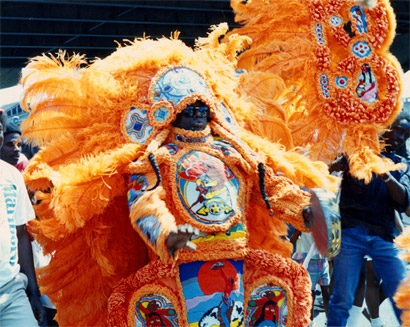
Big Chief Larry Bannock; photo by Paula Stratton
Their actual history is a bit cloudy. Some say it started as a homage to the days when runaway black slaves fled into the swamps and formed alliances with the Creeks, Cherokee and Seminoles. Intermarriages were common and generations of New Orleanians trace their lineage back to that time. Masking Indian was seen by both white and black cultures as organized street gangs from notorious neighborhoods “up to no good”. Mardi Gras offered an opportunity for rival gangs to disguise themselves and go settle scores across town. Uptown Indians fought with Downtown Indians and the result was confrontation and bloodshed. The police to this day still have a wary suspicion of these gatherings. Eventually, actual fights between tribes evolved into stylized mock battles: Thread and needle have replaced guns and knives.
Someone once said that New Orleans is the antidote to minimalism: Everything in excess. Mardi Gras Indians took this to heart with a passion. Their participation in Carnival evolved into a display of public art and outstanding craftsmanship, but kept its rebelliousness alive. Nobody could tell a Mardi Gras Indian what to do on Mardi Gras morning. Their culture became a self-evolving folk art and a wellspring of New Orleans music. The wanderings of the tribes took on more of a celebratory aspect with battle chants becoming popular street music rhythms. New Orleans’ Creole patois still intact, Indian music was an important influence on such musicians as Jelly Roll Morton (once a “Spy Boy” in his youth). Also Louis Armstrong, Professor Longhair, Dave Bartholomew, Fats Domino, Dr. John and the Neville Brothers had this influence to their sound. From there it snaked across America in pop Rhythm and Blues.
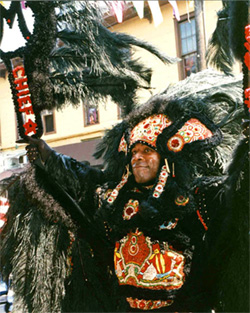
Unnamed Chief; photo by Paula Stratton
The parade, with its roots in deadly confrontations, is now a battle of tribes fought with dance, song and elaborate dress, with the Chief’s “suit” being the most important. A ritualized confrontation of socially-ranked participants, precedes the arrival of each tribe’s Chief — and sometimes their Indian Queens and children — who dance, sing and boast about their suits’ finer qualities. The hierarchy of these tribes is set up to carry out these battles. Out front was the “Spy Boy” — the lookout — vigilant for the approach of other tribes. His signal to the “Flag Boy” set off an alert for danger. Followed by the “Wild Man”, whose horned headdress indicated that his duty was to keep crowds clear for the “Big Chief”, a man of high esteem. Moving up the ranks required skill in designing their elaborate suits. The winner of this stylized battle was the one who presented the most magnificent display. Being called “pretty” was a major compliment and acknowledgement was hard to come by.
Mardi Gras Indians will spend an entire year making a new suit. To wear one twice is a disgrace worthy of being called out in public. In the creation of these eight-foot-tall plumed Indian suits a man who is a shipyard welder 364 days a year can step out his door to his “Nation of Indians” and lead his people parading and singing around the city on Mardi Gras Day. One gang would meet another at Shakespeare Park or on Saint Claude Avenue near the projects and challenge each other to what is essentially an aesthetic design competition — one that is taken very seriously.
The Mardi Gras suit is divided into parts in somewhat the same way European suits of armor were constructed: breastplate, leggings, arm sleeves, moccasins, and crown. Weighing up to 150 pounds in the heat and humidity of the Crescent City, wearing one of these suits is an achievement all by itself. They’re made of canvas and covered in velvet and ribbons, and then encrusted with seperately beaded illustrations called “patches”, and finally encircled with three- to four-foot-high plumed feathers. All of them highly illustrated with beaded images on every angle. To call it a costume would be to miss the point.
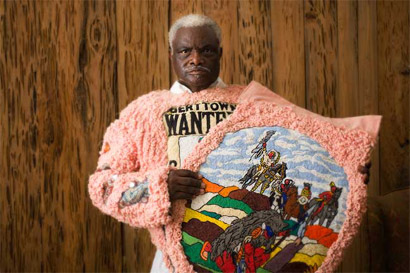
Big Chief Larry Bannock; photo by Will Crocker
The patches are usually depictions of American Indian themes: wolves, bears, eagles, and depictions of American Plains Indians, Apaches and Cheyenne braves. Rebellious figures like Geronimo and Sitting Bull are popular. Usually about twelve by sixteen inches and tightly sewn on with thread, seed beads and rhinestones. Thousands of them in each picture sown on. One by one. Since the colors are limited, the final art is intensely graphic. A Technicolor mosaic-like framed image, say, of a red skinned renegade warrior riding a painted pony under a turquoise sky near an orange and brown mesa. Outside, on the street, it looks like diamonds and rubies.
Everything about a suit is handmade. Ostrich plumes bought from a distributor in New York were the only outlet for their crowning glory, instructed to be dyed in the brightest colors: Shining Yellow, Fiery Orange, Hot Pink and Lime Green. It is difficult to describe the sight of ten Mardi Gras Indians parading on a sunny Carnival Day with their feathers blowing and beaded patches glittering, rippling in color. People almost get high on the color. It’s like a meeting of macaws in the Amazon rainforest.
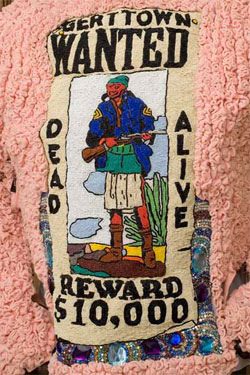
Photo by Will Crocker; illustration by Mark Andresen; beading by Big Chief Larry Bannock
Today the Chiefs are dwindling to a chosen few. Suits are sold to museums. Young men are too impatient to sew or follow the respect of their elders’ tradition. Gangs are replacing tribes once again in a city lost to chaos. For over a dozen years I drew pictures mostly for one Chief: Larry Bannock, the Big Chief of Chiefs. He came from Gert Town, one of the poor neighborhoods. Often times, he would have been sewing all day and night to meet that dawn on Mardi Gras morning. Living at subsistence level now, he’s determined to keep that tradition alive. And so am I.
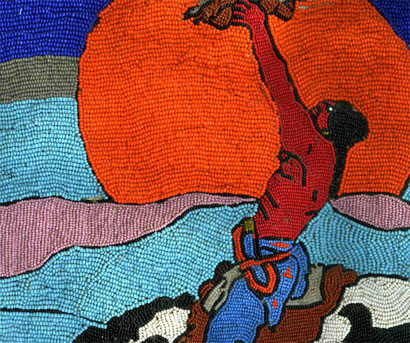
Illustration by Mark Andresen; beading by Big Chief Larry Bannock
The last time I was there, his neighborhood looked more like some apocalyptic dream than any conceivable American city. It’s shocking and shameful that after a year, the wreckage is still so extensive. Chief Bannock’s house is still broken and he sometimes lives in his car, but he continues to be the Mardi Gras Indian Chief of the 17th Ward known as Gert Town. As an ambassador of New Orleans culture, he needs help in the aftermath of Katrina. Many of us who have known him for years have been doing what we can to give him financial aid. But we are too hard hit ourselves to be as supportive as we we’d like. And we can’t bare to see culture and tradition lost to negligence. The plight of New Orleans after the catastrophe is very real. And it is also cultural. As visual communicators and translators of culture we can not afford a loss like this.

Speak Up would like to offer the opportunity to anyone who is interested in directly helping Big Chief Larry Bannock and his effort to maintain this tradition alive. Donation amounts are left to your consideration. All the funds will go directly to Larry Bannock and Speak Up will cover the PayPal transaction expenses.
If donations are not your cup of tea, you may also help Larry Bannock by comissioning hand-made beading. You’ve seen what he can do. Your next great poster, ad or package could look swell.





Mark,
What I'm most curious about, is whether or not any candidates have brought these cultural gems to light during this year's legislative and gubernatorial elections. Are they really in danger of going the way of dinosaurs? Arts, crafts, and design don't come into politics often, unless you're talking about the Lower Manhattan Development Project and the new skyscraper starchitects hope to build. Don't these Chiefs and Queens deserve equal attention? Or at least, national attention?
On Oct.25.2006 at 09:03 AM